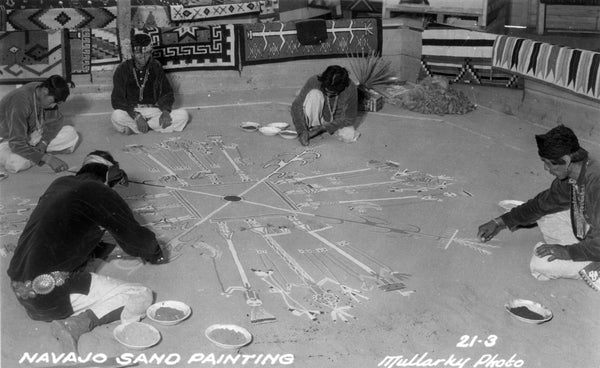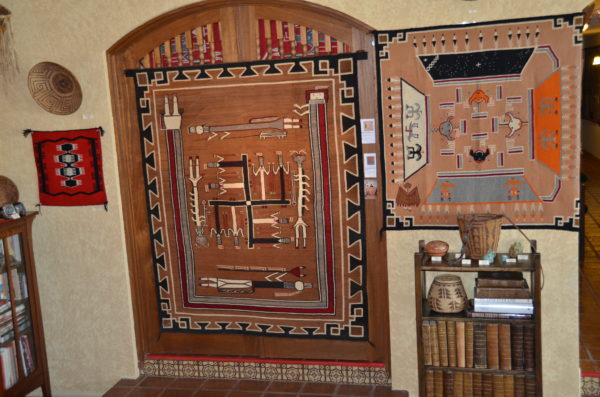NRG: Navajo Sandpainting Weaving
The 'Navajo Sandpainting Weaving'
Preserves Tradition and Ceremony
The Navajo Sandpainting Weaving is ranked among the Navajo tribe's best known and best loved art forms. The original Navajo dry painting is traditionally performed for religious or medicinal purposes; it is a sacred practice. Sandpaintings are used in ceremonies designed to summon supernatural forces, they represent the Navajo's religious world and are customarily part of ceremonies that will heal and restore a patient that is out of balance.
The Navajo Sandpainting Textiles: an artform that owes it's existence to weaver, artist, and Medicine Man, Hosteen Klah (also spelled Hasteen, Hastiin). From Native American Roots.net:
In the 1880s, Klah began to learn weaving from his mother and from his sister. He first began to learn the Navajo medicine ways – chanting and sandpainting – from his uncle. In learning the Nightway ceremony, Klah worked under the guidance of Laughing Singer and Tall Chanter. While most Navajo singers can master only one or two complete chants, Klah mastered at least eight. Among the ceremonies which he mastered were the Hailway, the Mountainway, the Nightway, the Windway, and the Chiricahua.
Among the Navajo, the purpose of the chant is to cure the sick. For the chant to work, it must be repeated exactly by the singer. Learning a chant takes a considerable amount of intellectual work: each one is like memorizing hundreds of lines of song or poetry. When a singer contracts to perform a ceremony, he undertakes a great deal of responsibility for not only the patient, but also others who are present at the ceremony.
In 1917, after 24 years of study, Hosteen Klah performed his first Nighway Ceremony (Yeibichai). The nine-day ceremony was perfect in chant, symbol, and ceremony and established him as a great singer.
In 1911 Hosteen Klah wove a blanket of yeibichai dancers which portrayed sacred masks. Local singers felt that this was sacrilegious and demanded that Klah have a ceremony to expel the evil and that he destroy the weaving. Instead, Klah sent the weaving to Washington and experienced no negative effects.
In 1917 Klah took Franc Newcomb, a trader’s wife, to a Nightway ceremony. After the ceremony, she attempted to draw from memory the designs from the sandpaintings which were used in the ceremony. She was unsuccessful and Klah sketched them for her in pencil. Newcomb then made these into watercolor reproductions and hung them in her bedroom so that the other Navajo would not be offended. After seeing that no punishment occurred, Klah then did an additional 27 paintings for her.
In 1919 Klah began to weave sandpainting rugs which were based on the chants he was qualified to sing. His first sandpainting weaving was a whirling log design from the Nightway ceremony.
Klah’s last sandpainting weaving, The Skies from the Shootingway ceremony, was done in 1937 and was not complete at the time of his death. The work was finished by his nieces, Gladys and Irene Manuelito.
Over the years, Klah worked with a number of non-Indian scholars and allowed them to record his songs, ceremonies, stories, and sandpaintings. His only Navajo student – Beaal Begay – died suddenly in 1931 and so much of his knowledge was not passed on in the traditional Navajo way.
One of the Anglos who worked with Klah was Mary Cabot Wheelwright (introduction through the Newcombs) who founded the Museum of Navajo Ceremonial Art in 1937. She had been permitted to record many of Klah’s songs and erected the museum to preserve his medicine knowledge and his sacred objects.
The museum is now known as the Wheelwright Museum. The Museum displays many of his drawings and paintings of sand paintings, as well as his sandpainting weavings. The Wheelwright is no longer actively involved in the study of Navajo religion, however it maintains growing, world-renowned collections that document Navajo art and culture from 1850 to the present. It also presents changing exhibitions on traditional and contemporary Navajo and other Native American arts.
Examples of the fine Sandpainting Weavings available from Nizhoni Ranch Gallery
It's our great pleasure to offer information and guidance to novices uninitiated in the fascinating world of Native American art. It's also our delight to offer the highest possible quality of contemporary and historic Navajo textile art to those experts who best appreciate their merit. Whether you're just discovering the wonders of Navajo art or have already amassed an important collection, you'll find a treasure trove of items here.




